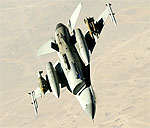Air Force F-16s, MQ-1 Predators likely to step up airstrikes in Afghanistan
 U.S. generals, who for months have been arguing in favor of employing more air power in Afghanistan to counter the Taliban’s advances, are finally getting their wish.
U.S. generals, who for months have been arguing in favor of employing more air power in Afghanistan to counter the Taliban’s advances, are finally getting their wish.
Defense officials on Friday announced that the White House has approved an expansion of U.S. airstrikes against the fundamentalist group, giving more authority to U.S. commanders to call in aerial backup for Afghan and U.S. forces on the ground.
The approval paves the way for aircraft like the Air Force F-16 and MQ-1 Predator to launch more attacks on the Taliban.
The move in Afghanistan mimics the U.S. approach toward the air war against the Islamic State, where commanders have much more latitude to decide which targets to go after. Defense officials in April announced changes are on the way for how airstrikes over Iraq and Syria are approved, giving ground commanders direct authorization for a "rapid execution of strikes.”
Since 2014, when the initial drawdown of U.S. troops in Afghanistan began and the U.S.-led Operation Enduring Freedom gave way to a follow-on NATO-led mission called Resolute Support, strikes against the Taliban have been limited. The U.S.-specific mission in Afghanistan, Operation Freedom’s Sentinel, includes two core components: an advise and assist mission, working with allies and partners on Resolute Support; and continuing “counterterrorism operations against the remnants of al-Qaida to ensure Afghanistan is never again used to stage attacks against our homeland,” Defense Secretary Chuck Hagel said in late December 2014.
But the Obama administration has struggled to define the Taliban’s role in Afghanistan, and in 2015 defined the group as an “armed insurgency,” not a terrorist group.
While U.S. and NATO forces were free to launch attacks on al-Qaida, Islamic State and several other terrorist groups, they could only attack Taliban forces if they were directly attacking coalition forces, especially Afghan army troops, or could be directly tied to previous attacks on friendly forces.
These stringent rules of engagement were meant to avoid "unintentional casualties and unwanted damage," said Mark Gunzinger, a senior fellow at the Center for Strategic and Budgetary Assessments. Such attacks could "frankly, hurt your overall objective," he added, meaning to maintain open channels of communication with the Afghan government and push for diplomatic resolutions.
"This is not a major air campaign," Gunzinger, a former advisor to the Air Force, told Air Force Times in late May. "It is an air support operation."
Many critics of the policy, including retired Army Gens. David Petraeus, former head of U.S. Central command, and John Campbell, who commanded the International Security Assistance Force and United States Forces–Afghanistan, from August 2014 to March 2016, urged the administration to revisit its policy of limited engagement.
"Simply waging the Afghanistan air-power campaign with the vigor we are employing in Iraq and Syria — even dropping bombs at a fraction of the pace at which we are conducting attacks in those Arab states — will very likely make much of the difference between some version of victory and defeat," Petraeus said in a Wall Street Journal commentary he co-authored last month.
Before he left Kabul on March 2, Campbell urged the Afghan army to change its tactics before the upcoming summer "fighting season," spending less time manning checkpoints and more time taking the fight directly to the militants.
“Afghanistan is at an inflection point,” Campbell said during testimony before the House Armed Services Committee in February. “I believe if we do not make deliberate, measured adjustments, 2016 is at risk of being no better, and possibly worse, than 2015."
Airstrikes on upward trend
Just one month into 2016, the U.S. had released almost 130 weapons in Afghanistan, the most since 2013, according to U.S. Air Forces Central Command statistics.
In April, there were more than 390 close-air support sorties, Capt. Matthew Chism, a Resolute Support spokesman, recently told Air Force Times. Of those sorties, 38 included air-to-ground strikes, with a total of 62 weapons released iun support of U.S. and alliedf forces on the ground.
The U.S. Air Force, which has carried out a steady flow of sorties against al-Qaida and ISIS in Afghanistan, has been at the forefront of the air wars in the Central Command area of operations. CENTCOM is home to “more than 750 total aircraft available to take the fight to the enemy” daily from bases throughout the region, Air Force Maj. Omar Villarreal, a spokesman for U.S. Air Forces Central Command, told Air Force Times May 28.
Villarreal said recent U.S. aircraft flying in Afghanistan include, but are not limited to:
F-16Cs, which have flown more than 2,040 close-air support sorties since Resolute Support began;
KC-10s and KC-135s, together flying nearly 2,000 air refueling sorties;
MQ-1 Predators and MQ-9 Reapers, which have flown about 2,000 intelligence, surveillance and reconnaissance sorties and are capable of launching precision missile attacks.
“In addition to the U.S. assets mentioned above, our coalition partners contribute to the fight with their own aircraft, and Afghan forces have the A-29 and MD-530 [helicopter], which provide close-air support capability,” he said in an email.
In April, the Super Tucanos conducted their first close-air support strikes. The Air Force delivered four A-29s to Afghanistan in January, just one month after the first Afghan pilots and maintainers for the close-air support aircraft completed their training at Moody Air Force Base, Georgia.
Villarreal reiterated that “the Resolute Support mission in Afghanistan is not a combat mission. Its purpose is to train, advise and assist Afghan security forces.”
But as the U.S. military footprint has shrunk — 9,800 U.S. troops are now in Afghanistan, but not involved in direct combat — the best way to ensure that Afghan security forces gain the upper hand in a country awash with terrorists and militants may be to boost the level of aerial strike support.